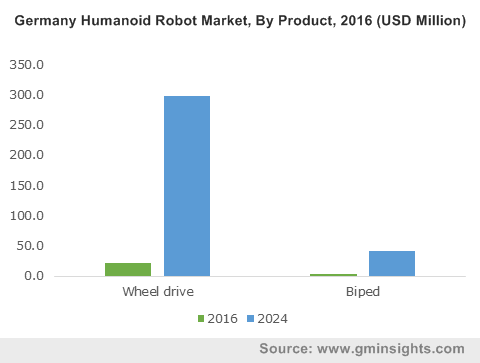Home > Pressrelease > Humanoid Robot Market Size to exceed $5.5bn by 2024
Humanoid Robot Market Size to exceed $5.5bn by 2024
- Published Date: August 21, 2019
Humanoid Robot Market size is set to exceed USD 5.5 billion by 2024; according to a new research report by Global Market Insights Inc. The worldwide shipments will register around 40% growth during the projected timeframe.
Government initiatives across various regions are encouraging the adoption of human-like robot technologies, adding up to the humanoid robot market development. Governments are promoting the use of robotic technology in manufacturing & retail industries to achieve automation benefits. The industry is witnessing high investment in R&D activities, supporting prototype development for various applications. Moreover, the increasing use of humanoid robots for security applications coupled with high consumer awareness for the adoption of such systems will fuel the humanoid robot market demand over the forecast timeline. These systems are witnessing increased deployment in the retail & hospitality sector for handling customer engagements that are equipped with enhanced facial & speech recognition tools, emotion recognition capabilities as well as armed with advanced AI tools.
The high cost of human-like robotic systems is expected to present a threat to its adoption in price-sensitive regions. The implementation of highly efficient and costly raw materials & components in these machines will increase the production and overall price. These cost parameters will limit the deployment chances in SMEs and companies with low investment capabilities. However, the price of these products is expected to decrease over the forecast timeline owing to reduced component prices, increased product availability, and enhanced consumer industries.

Get more details on this report - Request Free Sample PDF
In the humanoid robot market, wheel drive robots are experiencing high traction in recent years due to rapid technological developments in countries including China, the U.S., etc. These countries are undergoing rapid evolution in industrial & commercial sectors and have requirements for robotic technologies. In order to reduce the work pressure of humans, the trend of the IIoT & Industry 4.0 is adding up to the deployment of these machines in manufacturing units, warehouses, etc. The rapid adoption of technological advancements in China and Japan to address high requirements of the retail & e-commerce sector will compel industry players to deploy such machines that provide efficiency to manage & control operations. Additionally, these models are gaining usage in the automobile sector with the implementation in autonomous driving applications, contributing to the industry expansion.
Browse key industry insights spread across 180 pages with 223 market data tables & 24 figures & charts from the report, “Humanoid Robot Market Size By Product (Wheel Drive, Biped), By Application (Retail, Hospitality, Education & Scientific Research, Healthcare, Residential, Military & Defense, Construction, Underwater Systems), Industry Analysis Report, Regional Outlook, Growth Potential, Price Trends, Competitive Market Share & Forecast, 2017 – 2024”in detail along with the table of contents:
https://www.gminsights.com/industry-analysis/humanoid-robot-market
In the humanoid robot market, construction applications will grow at 19.5% CAGR from 2017 to 2024 due to the evolution of automated equipment & machines for performing basic labor tasks. The newly developed construction-specific robotic systems can perform complete drywall installation by themselves. These machines can detect surrounding environments and objects and support human workers with high safety. Increasing infrastructure development investments and the need to complete building constructions at a rapid pace are creating opportunities for the deployment of these machines to offer high support to human workers. These products are expected to gain high demand in the countries including North America and Europe with labor shortage and high labor cost. In October 2018, Advanced Industrial and Science Technology (AIST), announced the launch of its new HRP-5P bot, which is programmed to perform basic tasks in the construction sector such as hanging of plywood and drywalls.
Increasing initiatives by the European Commission for industrial infrastructure enhancement and to promote the usage of automated systems across all industries are developing the Europe humanoid robot market. The robust automotive manufacturing sector in Germany, Italy, etc., is incorporating human-like robots to gain high operational efficiency in production operations. Moreover, government regulations to promote high safety & security in all industries create the need for these systems. European companies and research institutions are investing huge amounts in developing these systems. For instance, in March 2018, Istituto Italiano di Tecnologia and University of Pisa announced the development of a humanoid robot that can perform fire & accident handling operations in case of natural disaster, factory accidents, and emergencies.
Qihan Technologies, Softbank Robotics, Ubtech Robotics Inc., Pal Robotics, Willow Garage, Engineered Arts, and Hanson Robotics are some of the major companies in the humanoid robot market. The players are strongly focusing on R&D to incorporate advanced technologies, such as AI, IoT, and big data, to make the robots capable with more human-like features. Large corporations and businesses with significant investment capabilities are making huge investments in the technology, considering its enormous potential to transform the way of operations in various applications. Moreover, industry players are partnering with multiple distributors across various regions to increase the reachability.
The humanoid robot market research report includes in-depth coverage of the industry with estimates & forecast in terms of revenue in USD and shipment in units from 2015 to 2024, for the following segments:
By Product
- Wheel drive
- Biped
By Application
- Retail
- Hospitality
- Education & Scientific Research
- Healthcare
- Residential
- Military & Defense
- Construction
- Underwater systems
- Others
The above information has been provided for the following regions and countries:
- North America
- U.S.
- Canada
- Europe
- UK
- Germany
- France
- Italy
- Russia
- Asia Pacific
- China
- India
- Japan
- South Korea
- Latin America
- Brazil
- Mexico
- Middle East & Africa (MEA)
- South Africa
- Saudi Arabia
- UAE